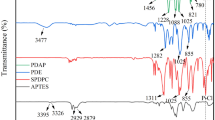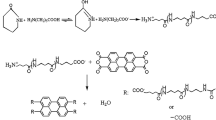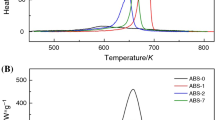Abstract
A novel aliphatic–aromatic polyamide poly(diethylenetriamine terephthalamide) (PDTA) was synthesized by using terephthaloyl chloride (TPC) and diethylenetriamine (DETA). A ammonium polyphosphate (APP)/PDTA mixture was prepared for use as an intumescent flame retardant (IFR) for acrylonitrile–butadiene–styrene terpolymer (ABS). The structure of PDTA was characterized by Fourier transform infrared spectroscopy (FTIR) and 1H NMR. The thermal properties and thermal decomposition model were investigated by differential scanning calorimetry (DSC) and thermogravimetric analysis (TG). The flame-retardant effect, thermal degradation behavior, and mechanism of IFR–ABS were investigated by limiting oxygen index (LOI), vertical burning test (UL-94), microscale combustion calorimetry test (MCC), TG, FTIR, and scanning electron microscopy (SEM). The results showed that PDTA was synthesized as expected and was stable below 200 °C. The results also showed that when the loadings of ABS, APP, and PDTA were 70, 22.5, and 7.5 %, respectively, the LOI value reached 31 % and the UL-94 vertical burning test was V-0. What is more, even when the addition of IFR was decreased to 25 %, the LOI value of the ABS/APP/PDTA (75/18.75/6.25) system was 28 %, indicating compounding APP and PDTA could improve the flame-retardant performance of ABS. The FTIR indicated there was a chemical reaction between APP and PDTA to form a heat-resistant triazine ring, and SEM indicated the ABS/APP/PDTA systems had a denser char structure than that of pure ABS.











Similar content being viewed by others
References
Chen L, Cai XF. Investigation on the halogen-free flame-retardant ABS. Sichuan: Sichuan University; 2006.
Su WG, Wu ZP. Research progress and investigation of intumescent flame retardants. Plast Addit. 2002;2:1.
Wu WH, Liu S, Wang YX, Shen TF, Gao M. Thermal degradation and flame retardancy of rigid polyurethane foams containing a novel intumescent flame retardant. J Therm Anal Calorim. 2014;117:1419–25.
Zhou C, Peng C, Liu L, Nie SB. Thermal oxidative degradation kinetics of novel intumescent flame-retardant polypropylene composites. J Therm Anal Calorim. 2015;120:1183–91.
Wang JC, Jiang JM. Fire-retardant, the newest progress and development direction of intumescent flame retardants. Flame Retard Mater Technol. 2001;5:5–10.
Ou YX. Flame retardants-manufacturing, properties and applications. Peking: Weapon Industry Press; 1997. p. 169.
Le BM, Bourbigot S. Fire retardancy of polymers: the use of intumescences. Cambridge: The Royal Society of Chemistry; 1998. p. 64.
Baljinder KK, Horrocks AR. Complex char formation in flame retardant fiber: intumescent combinations II. Thermal analytical studies. Polym Degrad Stab. 1996;54:289–303.
Zhang J, Ji KJ, Xia YZ. Polymer combustion and fire-retardant technology. Peking: Chemical Industry Press; 2005. p. 94.
Chen XY, Sun T, Cai XF. The investigation of intumescent flame-retarded ABS using zinc borate as synergist. J Therm Anal Calorim. 2014;115:185–91.
Qi SH, He MS, Li BX, Nie SB. Synergistic effects of zeolites on a novel intumescent flame-retardant low-density polyethylene (LDPE) system. J Therm Anal Calorim. 2013;114:581–7.
Bourbigot Serge, Le Bras Michel. Recent advances for intumescent polymers. Macromol Mater Eng. 2004;289:499–510.
Ma ZL, Gao JG, Qin JL. Effect of intumescent flame retardants on property for PP. China Plast Ind. 2003;31:40–2.
Ma ZL, Zhang WY, Liu XY. Using PA6 as a charring agent in intumescent polypropylene formulations based on carboxylated polypropylene compatibilizer and nano-montmorillonite synergistic agent. J Appl Polym Sci. 2006;101:739–46.
Tang Y, Hu Y, Xiao JF, et al. PA6 and EVA alloy/clay nanocomposites as char forming agents in poly(propylene) intumescent formulations. Polym Adv Technol. 2005;16:338–43.
Yi JS, Lu CX. Synergistic flame retardant effect of adjuvant on the ABS/APP/PETA system. J Chem Eng Chin Univ. 2011;25:319–24.
Peng C, Yuan SJ, Zhang MX, Nie SB. Thermal and flame retardant properties of novel intumescent flame retardant polypropylene composites. J Therm Anal Calorim. 2013;113:865–71.
Wang J, Cai XF. Research progress in halogen-free intumescent flame retardants. China Plast. 2011;25:9.
Yin HQ, Yuan DD, Cai XF. The high efficiency two stage intumescent contractive flame retardant on ABS. Polym Degrad Stab. 2013;98:288–96.
Xu Y, Yuan L, Wang Q. Melamine polyphosphate/silicon-modified phenolic resin flame retardant glass fiber reinforced polyamide-6. J Appl Polym Sci. 2013;129:2171–6.
Liu J, Liao KR, Lu ZJ. Molecular structure of triazine derivatives and relationship between structure and flame retardant property of PP. Polym Mater Sci Eng. 1999;15:73–5.
Author information
Authors and Affiliations
Corresponding author
Rights and permissions
About this article
Cite this article
Chen, X., Cai, X. Synthesis of poly(diethylenetriamine terephthalamide) and its application as a flame retardant for ABS. J Therm Anal Calorim 125, 313–320 (2016). https://doi.org/10.1007/s10973-016-5358-1
Received:
Accepted:
Published:
Issue Date:
DOI: https://doi.org/10.1007/s10973-016-5358-1




